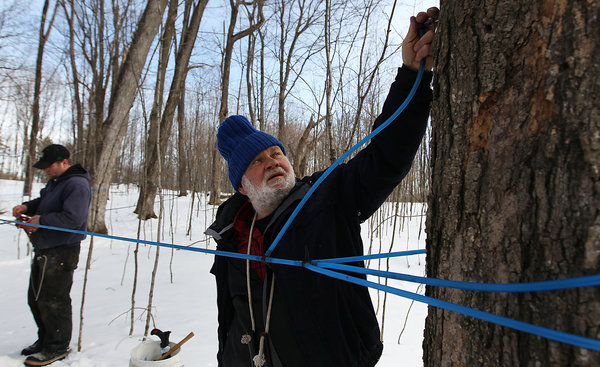Maple syrup takes turn toward technology
EAST MONTPELIER, Vt. — The rich, sweet tang of sap being boiled into maple syrup greeted tourists at Burr Morse’s sugar shack here this month — along with Mr. Morse, every inch the rural maple farmer in worn baseball cap and syrup-stained jacket, stirring the steaming evaporator with an old-fashioned dipper.
“People want to have a nostalgia trip,” said Mr. Morse, 65, a seventh-generation maple syrup farmer and the patriarch of Morse Farm Maple Sugarworks. “They want to see something natural, like taking sap from a tree.”

Forty years ago, Mr. Morse would snowshoe into the forest with his father to collect sap from galvanized buckets and load them onto a tractor. The farm has not changed much since then, but the winters have. So has the maple syrup ritual itself.
Scientists say the tapping season — the narrow window of freezing nights and daytime temperatures over 40 degrees needed to convert starch to sugar and get sap flowing — is on average five days shorter than it was 50 years ago. But technology developed over the past decade and improved in recent years offers maple farmers like Mr. Morse a way to offset the effects of climate change with high-tech tactics that are far from natural.
Today, five miles of pressurized blue tubing spider webs down the hillside at Morse Farm, pulling sap from thousands of trees and spitting it into tubs like an immense, inverse IV machine. Modern vacuum pumps are powerful enough to suck the air out of a stainless steel dairy tank and implode it, and they help producers pull in twice as much sap as before.
“You can make it run when nature wouldn’t have it run,” Mr. Morse said.
His greatest secret weapon is a reverse-osmosis machine that concentrates the sap by pulling it through sensitive membranes, greatly increasing the sugar content before it even hits the boiler. The $8,000 instrument with buttons and dials looks like it belongs in a Jetsons-era laboratory more than in a Vermont sugarhouse. But it saves more fuel and money than every other innovation combined. With it Mr. Morse can process sap into syrup in 30 minutes, something that used to take two hours.
Scientists project that climate change will eventually make New England less suitable for maple forests, but that the trees will continue to thrive in Canada, which even now produces more than 80 percent of the world’s maple syrup.
So an increasing number of maple producers are betting on technology.
The biggest United States maple farmers have expanded their production acreage and are tapping more trees than ever before: the total was 5.5 million taps last year, compared with slightly over 4 million taps 10 years earlier.
As a result, United States maple syrup production hit a new high in 2011. In Vermont, the top-producing state, sap yield per tap has risen over the past decade.
Maple farms are installing equipment that may take 10 years to earn back their cost in syrup sales.
“Technology has greatly increased that ability to make a full-time living,” said Matthew Gordon, the executive director of the Vermont Maple Sugar Makers Association. “It’s not merely the supplemental income it once was.”
But these changes have drawn questions about sustainability. Purists criticize the “techno-syrup” trend, saying it alters syrup’s rustic flavor and sucks the life out of maple trees.
Wrong on both counts, says Timothy Perkins, a plant biologist who directs the Proctor Maple Research Center in Underhill, Vt., the world’s foremost academic center for the study of maple and maple syrup.
“It’s pretty darn hard to kill a tree by over-tapping it — we’ve tried,” said Dr. Perkins, leading a tour through the center, past long counters with beakers, microscopes and segments of maple, as well as vacuum gauges, spouts and pliers.
The center’s scientists, who are employed by the University of Vermont, have altered the face of the industry many times over with inventions to make sugaring more efficient and sanitary, including a special plastic spout that prevents tap holes from drying up or collecting bacteria.
The center’s studies have found that as long as maple farmers follow tapping guidelines, maple trees can supply much more sap than was previously thought.
“It’s like the tree is a sugar-filled straw, with water and sap that we’re sucking right out of the ground,” Dr. Perkins said. “The amount we can get out of the soil is unlimited, but the amount of sugar in the tree is limited.”
As for taste, a chemical analysis of maple syrup processed with and without reverse osmosis concluded that some flavor compounds had been affected. But when the Proctor center conducted a sensory evaluation with a panel of top maple syrup tasters, no one could tell the difference. Dr. Perkins estimates that as much as 90 percent of the syrup now sold passes through reverse osmosis, adding a new dimension to the official “state flavor” of Vermont.
Dr. Perkins believes that a few more technical improvements could slightly lengthen the maple season, which usually ends in early April. Eventually, though, tubing and vacuums will not be able to overcome the effects of winters with too few extended cold snaps. Weather that is too warm can give late-season sap a “buddy” flavor — a taste that has been compared to sweaty gym socks.
Mr. Morse keeps a couple of “pet buckets” — old-fashioned metal ones — on maple trees to show tourists how it used to be done. He also burns wood chips instead of oil to power the evaporator, his only other concession to the past.
“It keeps our image intact,” he said.
© 2025 Julia Scott.
